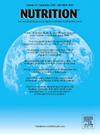Intermittent oro-esophageal tube feeding for cerebral small vessel disease patients with dysphagia: A randomized controlled study
IF 3.2
3区 医学
Q2 NUTRITION & DIETETICS
引用次数: 0
Abstract
Objectives
This study reported the clinical effect of intermittent oro-esophageal tube feeding (IOE) versus nasogastric tube feeding (NGT) on cerebral small vessel disease (CSVD) patients with dysphagia.
Methods
This randomized controlled study included 60 CSVD patients with dysphagia who received routine treatment. Participants were randomly divided into the intervention group (with IOE, n = 30) and the control group (with NGT, n = 30). The study lasted 15 days for each patient and assessments were conducted at baseline and after treatment. The primary outcome was dysphagia including Penetration-Aspiration Scale and Functional Oral Intake Scale. The secondary outcomes were 1) nutritional status, including (i) body mass index, (ii) serum albumin, (iii) hemoglobin, 2) aspiration pneumonia, 3) activities of daily living (ADL), 4) quality of life (QOL).
Results
At admission, there were no significant differences (P > 0.05) in baseline assessment. After treatment, both groups showed significant improvement in dysphagia, nutritional status, ADL, and QOL. There were significant differences (P < 0.05) between the two groups in dysphagia, nutritional status [body mass index: (19.53 ± 1.40) kg/m2 vs. (18.35 ± 1.54) kg/m2; albumin: (42.06 ± 2.64) g/L vs. (39.49 ± 2.77) g/L; hemoglobin: (128.85 ± 6.34) mg/L vs. (123.14 ± 7.92) mg/L], aspiration pneumonia (6.67% vs. 33.33%), ADL [(69.07 ± 6.33) vs. (63.56 ± 6.75)], and QOL [(78.07 ± 8.64) vs. (72.48 ± 7.76)]. There were no severe adverse events during the treatment.
Conclusions
Compared to NGT, IOE demonstrated advantages in improving dysphagia, nutritional status, ADL, QOL, and aspiration pneumonia in CSVD patients with dysphagia who received routine treatment.
求助全文
约1分钟内获得全文
求助全文
来源期刊

Nutrition
医学-营养学
CiteScore
7.80
自引率
2.30%
发文量
300
审稿时长
60 days
期刊介绍:
Nutrition has an open access mirror journal Nutrition: X, sharing the same aims and scope, editorial team, submission system and rigorous peer review.
Founded by Michael M. Meguid in the early 1980''s, Nutrition presents advances in nutrition research and science, informs its readers on new and advancing technologies and data in clinical nutrition practice, encourages the application of outcomes research and meta-analyses to problems in patient-related nutrition; and seeks to help clarify and set the research, policy and practice agenda for nutrition science to enhance human well-being in the years ahead.
 求助内容:
求助内容: 应助结果提醒方式:
应助结果提醒方式:


